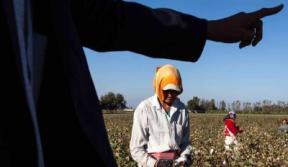Those few industries where child labor continues are concentrated in agriculture (especially cotton and cocoa), mining and small-scale weaving/sewing operations. This latter area is where the world’s football teams got the shock of their collective lives fifteen years ago. At the moment of most intense anti-sweatshop activism in the West – 1996 - soccer ball production was exposed as a pre-teens-in-penury cesspool; expensive, hand-stitched balls for export and bearing the world federation of football clubs’ “certified for match play” stamp of approval.
FIFA officers and staff did what almost any European business federation would do when faced with a complex worker rights issue – they contacted the global union headquarters in Brussels. So far so good. The trade union group helped them to work out a code of practice for supplier firms that included freedom of association and collective bargaining for workers, while addressing the issue of children who would be displaced by adult workers.
The global sportswear brands, however, formulated a much less onerous intervention which FIFA ultimately adopted, after adidas, Nike, et al, pointed out how lucrative the “replica jersey” market was for football club owners. Monitoring – such as it was - would be funded primarily through government grants yet it included no provision for labor law enforcement by authorities in Pakistan. Instead, there were "international" inspection teams set up under the now-common model of "social audit" self-regulation.
The monitoring scheme cost millions and produced no direct gains for workers. Realistically, only higher wages through collective bargaining would have had a serious impact on the region's child labor problem. This was what the international outcry demanded and it was the path that the FIFA had initially embarked upon. It must be said that thousands of children benefited from the Sialkot Project (SP) inasmuch as they gained access to education opportunities, many for the first time.
In mid-2006, Nike ended a sourcing agreement with Sialkot's leading producer, Saga Sports - a move that threatened the jobs of thousands of young Pakistanis. In the event, the work was shifted back in less than a year’s time. Nike's explanation for pulling the work included evidence that child labor was again a problem, despite 8 years of ILO, UNICEF, Save the Children (etc.) “monitoring.” This is a stellar example of "re-defining success". First, the demands of the international human rights community (for worker-empowerment) were turned aside in favor of a monitoring scheme; soon thereafter, educational outreach was (implicitly, at least) substituted for the difficult and assuredly more costly progress in workplace relations – collective bargaining.
The Corporate Self-Regulation Scam
“Compliance” has become a really big business now, but what an infernally vague and opaque system! Between 1996 And 1999 sweat-reliant businesses bought time – while concocting standards and oversight processes. Since 2001, armies of these companies’ consultants have been plaintively arguing at meetings around the globe that there were too many standards and processes to reasonably guide suppliers. Some business observers see the “compliance” house of cards about to tumble. A leading journal for purchasing and supply-management professionals put it this way:
“A recent report found ethical buying codes have done little to improve factory conditions overseas. For a decade now, companies have relied on these codes and on-site audits, safe in the belief they are doing the best they can to improve conditions for workers in their supply chains. But research published in October threatens to strip firms of this refuge, exposing the reality that more must be done if they are to make a genuine difference.” (Supply Management April 2007)
Stay tuned next week for more thoughts on the ILRF soccer ball report from Jeff Ballinger!

